
Nepal measures about 880 kilometers (547 mi) along its Himalayan axis by 150 to 250 kilometers across. It has an area of 147,516 km2 (56,956 sq mi).

Khadakwasla Dam is a dam on the Mutha River 21 km (13 mi) from the centre of the city of Pune in Maharashtra, India. The dam created a reservoir known as Khadakwasla Lake which is the main source of water for Pune and its suburbs.
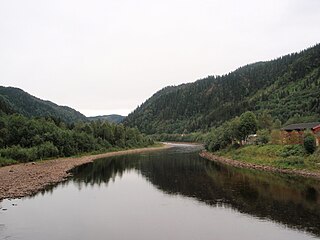
Gauldal or Gauldalen is a valley and traditional district in Trøndelag county, Norway. The river Gaula runs through the 145-kilometre (90 mi) long valley from the Røros mountains near the lake Aursunden to the Trondheimsfjorden. The narrow valley runs northwards from Røros to the Haltdalen area, where it widens some, turns and heads generally to the west to the village of Støren. At Støren it turns again and heads north through what is now a wide, agricultural valley until it reaches the sea just south of the city of Trondheim. The Rørosbanen and Dovrebanen railway lines follow the Gauldalen valley on their way to Trondheim. The European route E6 highway and the Norwegian County Road 30 also follow the valley.
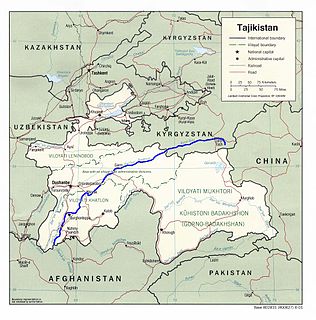
The Vakhsh, also known as the Surkhob, in north-central Tajikistan, and the Kyzyl-Suu, in Kyrgyzstan, is a Central Asian river, and one of the main rivers of Tajikistan. It is a tributary of the Amu Darya river.

Bold text

The Kosi or Koshi is a trans-boundary river which flows through Tibet, Nepal and India. It drains the northern slopes of the Himalayas in Tibet and the southern slopes in Nepal. From a major confluence of tributaries north of the Chatra Gorge onwards, the Kosi River is also known as Saptakoshi for its seven upper tributaries. These include the Tamor River originating from the Kanchenjunga area in the east and Arun River and Sun Kosi from Tibet. The Sun Koshi's tributaries from east to west are Dudh Koshi, Bhote Koshi, Tamakoshi River, Likhu Khola and Indravati. The Saptakoshi crosses into northern Bihar, India where it branches into distributaries before joining the Ganges near Kursela in Katihar district.
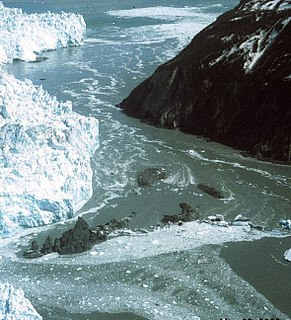
A glacial lake outburst flood (GLOF) is a type of outburst flood caused by the failure of a dam containing a glacial lake. An event similar to a GLOF, where a body of water contained by a glacier melts or overflows the glacier, is called a jökulhlaup. The dam can consist of glacier ice or a terminal moraine. Failure can happen due to erosion, a buildup of water pressure, an avalanche of rock or heavy snow, an earthquake or cryoseism, volcanic eruptions under the ice, or massive displacement of water in a glacial lake when a large portion of an adjacent glacier collapses into it.

The Presumpscot River is a 25.8-mile-long (41.5 km) river located in Cumberland County, Maine. It is the main outlet of Sebago Lake. The river provided an early transportation corridor with reliable water power for industrial development of the city of Westbrook and the village of South Windham.

The 1959 Hebgen Lake earthquake occurred in the western United States on August 17 at 11:37 pm (MST) in southwestern Montana.

Mosul Dam, formerly known as Saddam Dam, is the largest dam in Iraq. It is located on the Tigris river in the western governorate of Nineveh, upstream of the city of Mosul. The dam serves to generate hydroelectricity and provide water for downstream irrigation. At full capacity, the structure holds about 11.1 cubic kilometres (2.7 cu mi) of water and provides electricity to the 1.7 million residents of Mosul.
A landslide dam or barrier lake is the natural damming of a river by some kind of landslide, such as a debris flow, rock avalanche or volcanic eruption. If the damming landslide is caused by an earthquake, it may also be called a quake lake. Some landslide dams are as high as the largest existing artificial dam.

Tangjiashan Lake is a landslide dam-created lake on the Jian River, which was formed by the 2008 Sichuan earthquake. Its name comes from the nearby mountain Tangjiashan. On May 24, 2008 the water level rose by 2 metres in a single day, reaching a depth of 23 metres (75 ft), just 29 metres (95 ft) below the barrier level. On June 9 2008, more than 250,000 people had been evacuated from Mianyang in anticipation of the Tangjiashan Lake dam bursting.
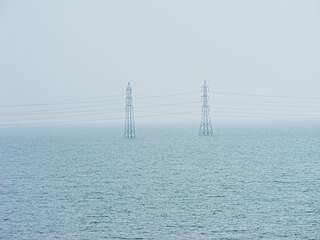
The 2008 Bihar flood was one of the most disastrous floods in the history of Bihar, an impoverished and densely populated state in India. The Koshi embankment near the Indo-Nepal border broke on 18 August 2008. The river changed course and flooded areas which had not been flooded in many decades. The flood affected over 2.3 million people in the northern part of Bihar.

The Araniko Highway connects Kathmandu with Kodari, 115 kilometres (71 mi) northeast of the Kathmandu Valley, on the Nepal-China border. It is among the most dangerous of highways in Nepal due to extremely steep slopes on each side of the road from Barabise onwards; massive landslides and bus plunges are not uncommon, especially after rains. At the Sino-Nepal Friendship Bridge, it connects with China National Highway 318 to Lhasa, and eventually to Shanghai.

The Sunkoshi, also called Sunkosi, is a trans-boundary river that originates in Tibet Autonomous Region and is part of the Koshi or Saptkoshi River system in Nepal.
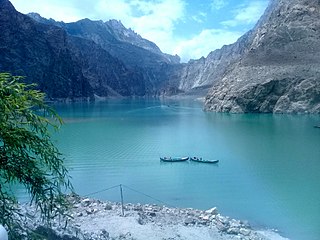
Attabad Lake is a lake located in the Gojal region of Hunza Valley in Gilgit−Baltistan, Pakistan. It was created in January 2010 as the result of a major landslide in Attabad. The lake has become one of the biggest tourist attractions in Gilgit−Baltistan, offering activities like boating, jet-skiing, fishing and other recreational activities.
Kosasthalaiyar River, also known as Kortalaiyar, is one of the three rivers that flow in the Chennai metropolitan area.
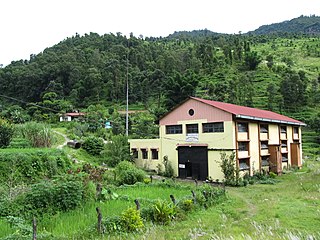
Sunkoshi Small Hydropower Plant is located in Dhuskun of Sindhupalchok District in central Nepal. It downstream where the Sunkoshi and Bhotekoshi Rivers meet. Construction on the plant began in 2003 and it was complete in 2005.
Landslides are triggered in Nepal due to a combination of steep mountains and unstable soils. The risk of the landslide is high in the monsoon season due to lubrication of soil in slope by moisture. Another important factor triggering the landslide is earthquakes. When landslide occurs near the river, it can block the river causing a damming effect. Damming could also occur due to rock-slides. Such dams are unstable and can cause flooding if not breached in controlled manner. Below is a list of dams formed due to landslides and their impacts in Nepal Annually, 593 natural disaster occurs in average and quite a few of them are related to the damming by landslides and about 13% of fatality is directly related to the landslide and Landslides Dammed Outburst Flood (LDOF).

The following is a list of weather events that occurred on Earth in the year 2014. There were several natural disasters around the world from various types of weather, including blizzards, cold waves, droughts, heat waves, tornadoes, and tropical cyclones. In September, floods in India and Pakistan killed 557 people. The costliest single event was Typhoon Rammasun, which killed 225 people and left over US$8 billion in damage when it moved through the Philippines, China, and Vietnam.




















